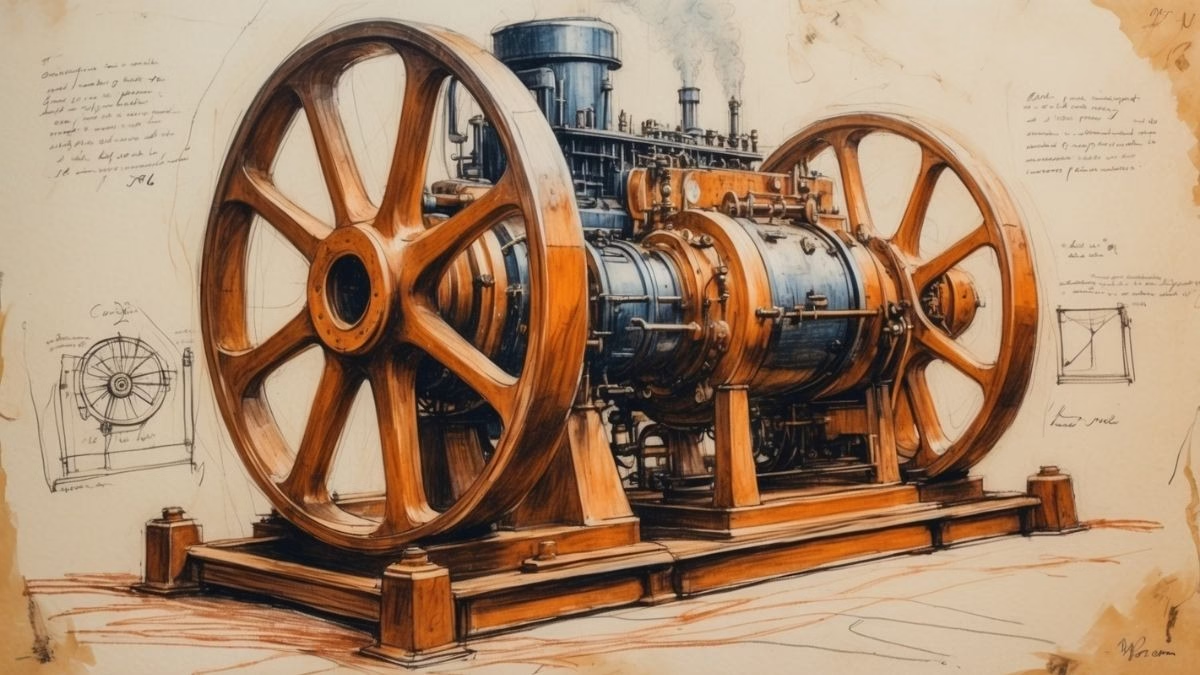Audio Episode
[ppp_patron_only level=5]
The Steam Engine_ Forging the Modern World Transcript: Click to Open
The Steam Engine Forging the Modern World
Have you ever, like, stopped to think about how our world actually got built? I mean, the clothes we wear, the cities we live in, even the fact that you can hop on a train and travel hundreds of miles in just one day. What if I told you that almost all of this, well, it can be traced back to one single noisy, really powerful invention. How did a soggy problem in a coal mine lead to this global revolution that completely reshaped societies and, you know, gave humanity unprecedented power? Welcome to a new introduction to a learning quiz from English Plus Podcast.
What you’re going to listen to is to help you ace the quiz. But if you prefer to attempt the quiz right away, you can do that because we have added hints and feedback for every option, and that’s what makes it a learning quiz, and a fun one if you ask me. But now let’s talk a little about what you may learn from this quiz.
Okay, so let’s unpack this whole thing. Our journey, it really kicks off not with some, you know, flash of genius, but actually with a very practical, pretty urgent problem back in 18th century Great Britain. You see, the world was getting seriously hungry for coal, but as miners dug deeper and deeper, their mines kept flooding constantly.
Yeah, they were literally drowning in water. It wasn’t just an inconvenience, it threatened the entire industry. So they desperately needed a way to pump all that water out just to keep digging, to keep the lights on, essentially.
It’s really fascinating, isn’t it, how such a specific, almost down-to-earth problem can spark something so massive. World-changing innovation. This wasn’t just about making mining a bit easier.
It was fundamental, keeping a vital energy source going. It really set the stage. Right, and that desperate need led straight to Thomas Newcomen back in 1712.
Now, he wasn’t building some sleek, modern machine. Think a huge, clanking, noisy contraption. He called it an atmospheric engine, and that name’s important because it wasn’t really a steam engine like we might picture today.
It was an atmosphere engine. How did that even work? Well, okay, picture this giant metal cylinder. Huge thing.
Newcomen would fill it up with steam, and that steam would push a piston upward. Okay, simple enough. But then, here’s the clever bit.
They’d spray cold water inside that hot cylinder. Wow. Yeah, right inside.
And that instantly condensed the steam back into water, creating this really powerful vacuum. And that’s when the air pressure around us, the atmosphere itself, which is immense, slammed the piston back down with incredible force. Ah, so the atmosphere did the work.
Exactly. The steam just created the vacuum. Then this up and down, up and down motion was hooked up to pumps, and bam, it could clear the mines.
It saved them. So, okay, it was clunky, probably deafeningly loud, but it worked. It actually proved you could convert heat into useful mechanical work on a big scale.
But it had a massive drawback, didn’t it? What was holding it back from being used everywhere? Oh, absolutely. Achilles heel was just how incredibly inefficient it was. Think about it.
To get that vacuum, you had to heat up this enormous metal cylinder, red-hot perhaps, then immediately douse it with cold water, then heat it all up again for the very next stroke. All that constant heating and cooling of tons of metal, it just wasted colossal amounts of heat. Which means it wasted colossal amounts of coal.
Precisely. It was an absolute fuel guzzler. Only really practical where coal was cheap, like right at the coal mine itself.
Okay. Enter James Watt, our next big player. He was a Scottish instrument maker, very bright guy.
In the 1760s, he gets this job, right, repairing a model of a Newcomen engine. He’s looking at it, tinkering with it, and he’s just struck by how much fuel it wastes, how inefficient it is. He saw the problem immediately.
All that wasted heat. After a lot of thinking, maybe pacing around his workshop, he has this eureka moment. What if? What if you didn’t have to cool the main cylinder down every single time? What if you could cool the steam somewhere else? Yeah.
Like a separate box? That was the genius insight. The separate condenser. It sounds simple, maybe, but it’s utterly revolutionary.
Watt realized the core issue wasn’t the steam itself, but making the main cylinder go hot-cold, hot-cold. So by adding this separate chamber, the condenser, where only the steam was cooled and turned back to water, he could keep the main cylinder hot all the time. Constant temperature.
Yes. And that saved enormous amounts of fuel, like drastically reduced fuel consumption, maybe 75% less fuel, something like that. It basically transformed the steam engine from this very specialized mind pump into something with the potential to power almost anything.
It really makes you think, doesn’t it? How often these huge leaps forward come from, well, not a totally new idea, but a really clever improvement on an existing one. Okay. This is where it gets really, really interesting for me.
So you’ve got this much, much more efficient engine. Great. But its motion is still just up and down, I think.
Great for pumping water. Yep. Still reciprocating.
But factories, especially the big textile mills that were starting up, they needed smooth, continuous rotary motion, turning wheels, driving shafts. How did Watt solve that? Right. Another problem.
And this shows Watt, especially with his business partner, Matthew Bolton, was more than just a brilliant inventor. He was practical. They came up with this ingenious system of gears called the Sun and Planet gear set.
Sun and Planet. Sounds cosmic. Huh.
Yeah, a bit. But basically, these gears cleverly converted that back and forth piston movement into the smooth, circular motion that factories needed. It allowed the engine to turn a drive shaft continuously.
Brilliant. So now you have efficient and rotary power. Exactly.
Ready for the factories. And Watt didn’t stop there, did he? He needed to sell these things. He came up with a way to actually quantify the power, a term we literally still use every single day.
Absolutely. Horsepower. It was pure marketing genius.
Think about it. Before Watt, how did you measure power? Maybe by how many horses you needed. So Watt literally did experiments, figured out roughly how much work a good, strong horse could do over a sustained period.
Then he could go to a factory owner, someone used to thinking in terms of horses, and say, look, my engine, it provides the steady power of, say, 50 horses all day, all night. That’s relatable. That’s tangible.
Completely. It gave people an immediate grasp what this newfangled machine could actually do. He didn’t just sell an engine.
He sold understandable, quantifiable power. Bridge the gap between this abstract machine and real work. And the impact.
I mean, it just blows my mind. Before steam power, factories basically had to be built right next to fast-flowing rivers. They needed water wheels.
They were totally tethered to geography. Right. But now with Watt’s engines, you could build a factory.
Well, pretty much anywhere. As long as you can get coal delivered and had some water source, you were good to go. That freedom.
That decoupling from the landscape. It was revolutionary. It triggered one of the biggest social shifts in human history.
You mean people moving. Oh, absolutely. Millions of people started leaving the countryside, leaving centuries of agrarian life behind.
They moved to these new, rapidly growing industrial cities that were springing up all over the place. Cities basically built around these factories, powered by the constant thrum of steam engines. The scale of that migration, the urbanization, it’s hard to even picture.
It fundamentally reshaped how and where people lived, how economies worked, created entirely new social classes and problems too, of course. A whole new world, really. But the steam revolution wasn’t finished, was it? Stationary engines were changing industry, but some folks started dreaming bigger.
What about making the engine itself move? Right. Taking the power on the road, or rather on the rails and waves. But that presented a huge challenge, didn’t it? You needed an engine that was small enough, light enough, but also powerful enough for transport.
And that meant using steam at much higher pressures than in those big early engines and high pressure steam. Well, that was dangerous. Extremely dangerous.
Early boilers, if they weren’t built perfectly, could and did explode with devastating force, like bombs. So there’s real risk involved. Definitely.
It raises that classic question in innovation, right? The balance between risk and reward. These engineers were pushing the boundaries of material science and safety. They were daredevils in a way.
But pioneers like Richard Trevithick and then maybe most famously George Stevenson, they pushed through. They figured it out. They did.
And Stevenson’s locomotive, the Rocket, back in 1829. Yeah. That was the big moment for rail.
What did it prove? It proved that steam-powered rail travel wasn’t just some quirky experiment. It could be fast, reliable, and economically viable. It was the true birth of the iron horse.
And suddenly the world starts to shrink, doesn’t it? Trains connecting cities, crossing vast distances that used to take days or weeks, now possible in hours. It must have felt like science fiction. Absolutely.
And it wasn’t just land. Steam power took to the seas as well. Right.
The steamship. How did that change things? Think about sailing ships. Totally reliant on the wind.
Journeys could take weeks, months, or you could get stuck but calmed for days. Completely unpredictable. Yeah.
Frustrating. But a steamship, it could run on a schedule. Rain or shine, wind or no wind.
It could chug straight across the ocean. That predictability revolutionized global trade. You could plan shipments.
And it revolutionized migration too, making long sea voyages faster and more reliable for millions of people. The world became, in a practical sense, much smaller and more connected. So this steam engine, it really dominated for what, over 150 years? It literally forged the modern world we live in.
It absolutely did. Its reign was long and transformative. But eventually, things changed again.
Late 19th, early 20th century, new technologies started coming online. Yeah. Things like the electric motor, much cleaner and more adaptable for factories in many ways.
And of course, the internal combustion engine. More compact, leading to cars, eventually airplanes. So steam power kind of faded into the background for many applications.
So looking back now, what’s the big takeaway? What does this all mean for us today? Well, I think we should never, ever forget the steam engine. Why? Because it was the first. It was the very first machine that gave humanity serious power.
Power independent of muscles, wind, or water. Power independent of geography and weather. It did just make things faster.
It taught us the fundamental principle, how to turn heat into useful motion. And we still use that principle. Massively.
That basic idea, heat into motion, is still how we generate most of the world’s electricity today. Those giant power plants, they often use heat, maybe from burning coal, gas, or nuclear reactions, to create high-pressure steam. That steam then spins huge turbines, which are basically advanced descendants of Watt’s engine, and those turbines drive generators.
Wow. So it’s still there, just in a different form. Exactly.
Every time you flick on a light switch, charge your phone, whatever, you’re tapping into a direct technological lineage that stretches right back to those flooded coal mines and Newcomen’s clanking engine and Watt’s brilliant refinement. Amazing. So the next time you flick on that light switch, just take a second.
Remember that incredible chain of invention. It really did start with a flooded coal mine and a brilliant, simple idea about steam and pressure. We hope you learned a lot from this intro, but that doesn’t mean you shouldn’t take the quiz anymore.
There’s still a lot to learn from the quiz, because as we told you at the beginning of the episode, there are hints and feedback for every single option in the multiple-choice quiz, so you will learn from your mistakes as much as you will learn from the answers you get right. That’s why we call it an English Plus Learning Quiz, so go ahead and give it a go. And with this, we reach the end of another learning quiz from English Plus Podcast.
Don’t forget to check out our website, englishpluspodcast.com, not only for quizzes, but to take your English and knowledge to the next level. Thank you for listening, stay curious, and never stop learning.
[/ppp_patron_only]
Introduction
Ready to Discover the Machine That Changed Everything?
Have you ever stopped to think about what really kicked off the modern world as we know it? Before computers, before electricity, there was steam. The invention of the steam engine wasn’t just another new gadget; it was a revolution. It was the powerful, chugging, hissing heart of a new age that transformed how people worked, traveled, and lived.
But the story of its invention isn’t about one person having a single “eureka!” moment. It’s a fascinating tale of problems, puzzles, and brilliant minds building on each other’s work over many decades.
Think of this quiz as our own time machine. It’s not a test, but a fun, interactive way for us to explore this incredible story together. I’ll ask some questions to get you thinking, and with each answer, we’ll uncover another piece of the puzzle, meeting the key players and understanding the breakthroughs that put the world on a new track.
By joining me on this exploration, you’ll:
- Meet the Inventors: Discover the people behind the machine, from the early pioneers to the famous James Watt.
- Understand the “How”: Grasp the basic, brilliant ideas of how a steam engine actually works in a simple, straightforward way.
- Connect the Dots: See how a solution for a flooded coal mine led to locomotives, steamships, and the birth of factories.
- Gain a New Appreciation: See the world around you differently, knowing the story of the engine that started it all.
Ready to fire up the boiler and see what we can learn? Let’s get started.
Learning Quiz
This is a learning quiz from English Plus Podcast, in which, you will be able to learn from your mistakes as much as you will learn from the answers you get right because we have added feedback for every single option in the quiz, and to help you choose the right answer if you’re not sure, there are also hints for every single option for every question. So, there’s learning all around this quiz, you can hardly call it quiz anymore! It’s a learning quiz from English Plus Podcast.
[ppp_patron_only level=5]
[/ppp_patron_only]
Quiz Takeaways
Hello, and welcome. Take a look around you. The clothes you’re wearing, the device you’re reading this on, the very idea of living in a bustling city or traveling hundreds of miles in a single day—almost all of it can trace its roots back to one noisy, powerful, world-changing invention: the steam engine. This wasn’t just a new machine; it was the fiery heart of the Industrial Revolution, and its story is a fascinating tale of human ingenuity.
Our story doesn’t start with a flash of genius, but with a problem. In 18th-century Great Britain, the world was hungry for coal. But as miners dug deeper, the mines constantly flooded with water. They needed a powerful pump. This practical, urgent need was the mother of our invention.
The first breakthrough came from a man named Thomas Newcomen in 1712. He built a massive, clanking machine called an “atmospheric engine.” And it worked in a truly brilliant way. It wasn’t really a “steam” engine; it was an “atmosphere” engine. Imagine a giant cylinder. You fill it with steam, pushing a piston up. Then, you spray cold water inside. The steam instantly condenses, turning back into a few drops of water and creating a vacuum. What happens then? The immense weight of the air around us, the atmosphere, pushes the piston down with incredible force. This up-and-down motion was connected to a pump, and it saved the mines.
But the Newcomen engine had a flaw. It was incredibly inefficient. You had to heat the cylinder to fill it with steam, then cool it to create the vacuum, then heat it again for the next stroke. All this heating and cooling of a massive metal cylinder wasted a colossal amount of heat and, therefore, a colossal amount of coal.
This is where our most famous character, James Watt, enters the stage. Watt was a Scottish instrument maker, a brilliant thinker who, in the 1760s, was given a model of a Newcomen engine to repair. He was struck by its inefficiency. After much thought, he had his “eureka!” moment. What if you could cool the steam in a separate chamber? He designed a separate condenser. This meant the main cylinder could stay hot all the time, saving enormous amounts of fuel. This single innovation transformed the steam engine from a specialized mine pump into a potential power source for anything.
But there was still a problem. The engine’s motion was just up and down. To run a factory, you need a smooth, rotating motion. So Watt, with his business partner Matthew Boulton, invented an ingenious system of “sun and planet” gears that converted the piston’s back-and-forth movement into the rotary motion that could turn a driveshaft. Now, the steam engine was ready for the factory floor.
To sell his creation, Watt needed a way to explain its power. So, he invented a marketing term we still use today: horsepower. He calculated what a strong horse could do and could then tell a factory owner, “My engine provides the power of 50 horses.” It was a stroke of marketing genius.
The impact was revolutionary. Before steam, factories had to be built next to rivers to use water wheels. Now, you could build a factory anywhere you could get coal and water. This caused one of the greatest social shifts in history: millions of people left the countryside to move to new industrial cities, all powered by the hissing, clanking heart of the steam engine.
But the revolution wasn’t done. While Watt had perfected the stationary engine, others dreamed of making it move. The challenge was making an engine small and powerful enough. This required using steam at high pressure, which was dangerous—a poorly made boiler could explode like a bomb. Pioneers like Richard Trevithick and, most famously, George Stephenson, mastered this technology. In 1829, Stephenson’s locomotive, The Rocket, proved that steam-powered rail travel was not just possible, but fast and reliable. The “Iron Horse” was born, shrinking the world and connecting cities like never before.
At the same time, steam conquered the seas. While a sailing ship was at the mercy of the wind, a steamship could travel on a fixed schedule, revolutionizing trade and migration.
The steam engine’s reign lasted for over 150 years. It was the engine that forged the modern world. But eventually, the age of steam gave way to new technologies. In the late 19th and early 20th centuries, the development of the electric motor and the more compact internal combustion engine kicked off the next wave of change, giving us cleaner factories, the automobile, and eventually the airplane.
But we should never forget the steam engine. It was the first machine that gave humanity a source of power independent of geography and weather. It taught us how to turn heat into motion, a principle that, in the form of steam turbines, still generates most of our electricity today. The next time you flick on a light switch, remember the long chain of invention that started with a flooded coal mine and the brilliant, simple idea of harnessing the power of steam.










0 Comments